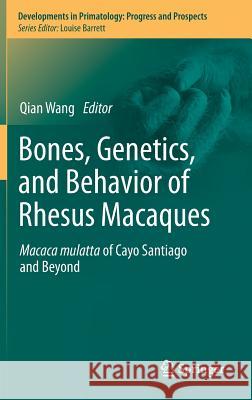Bones, Genetics, and Behavior of Rhesus Macaques: Macaca Mulatta of Cayo Santiago and Beyond » książka
Bones, Genetics, and Behavior of Rhesus Macaques: Macaca Mulatta of Cayo Santiago and Beyond
ISBN-13: 9781461410454 / Angielski / Twarda / 2011 / 310 str.
Bones, Genetics, and Behavior of Rhesus Macaques: Macaca Mulatta of Cayo Santiago and Beyond
ISBN-13: 9781461410454 / Angielski / Twarda / 2011 / 310 str.
(netto: 576,41 VAT: 5%)
Najniższa cena z 30 dni: 578,30
ok. 22 dni roboczych
Bez gwarancji dostawy przed świętami
Darmowa dostawa!
Foreword by Phillip V. TobiasThe introduction of rhesus macaques to Cayo Santiago, Puerto Rico in 1938, and the subsequent development of the CPRC for biomedical research, continues its long history of stimulating studies in physical anthropology. The CPRC monkey colonies, and the precise demographic data on the derived skeletal collection in the Center's Laboratory of Primate Morphology and Genetics (LPMG), provide rare opportunities for morphological, developmental, functional, genetic, and behavioral studies across the life span of rhesus macaques as a species, and as a primate model for humans. The book grows out of a symposium Wang is organizing for the 78th annual meeting of the American Association of Physical Anthropologists to be held in April 2009. This symposium will highlight recent and ongoing research in, or related to, physical anthropology, and reveal the numerous research opportunities that still exist at this unusual rhesus facility. Following an initial historical review of CPRC and its research activities, this book will emphasize recent and current researches on growth, function, genetics, pathology, aging, and behavior, and the impact of these researches on our understanding of rhesus and human morphology, development, genetics, and behavior. Fourteen researchers will present recent and current studies on morphology, genetics, and behavior, with relevance to primate and human growth, health, and evolution. The book will include not only papers presented in the symposium, but also papers from individuals who could not present their work at the meeting due to limitations in the maximum number (14) of permitted speakers.
The introduction of rhesus macaques to Cayo Santiago, Puerto Rico in 1938, and the subsequent development of the CPRC for biomedical research, continues its long history of stimulating studies in physical anthropology. The CPRC monkey colonies, and the precise demographic data on the derived skeletal collection in the Center s Laboratory of Primate Morphology and Genetics (LPMG), provide rare opportunities for morphological, developmental, functional, genetic, and behavioral studies across the life span of rhesus macaques as a species, and as a primate model for humans. The book grows out of a symposium Wang is organizing for the 78th annual meeting of the American Association of Physical Anthropologists to be held in April 2009. This symposium will highlight recent and ongoing research in, or related to, physical anthropology, and reveal the numerous research opportunities that still exist at this unusual rhesus facility. Following an initial historical review of CPRC and its research activities, this book will emphasize recent and current researches on growth, function, genetics, pathology, aging, and behavior, and the impact of these researches on our understanding of rhesus and human morphology, development, genetics, and behavior. Fourteen researchers will present recent and current studies on morphology, genetics, and behavior, with relevance to primate and human growth, health, and evolution. The book will include not only papers presented in the symposium, but also papers from individuals who could not present their work at the meeting due to limitations in the maximum number (14) of permitted speakers.











